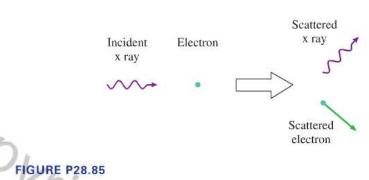X-ray diffraction can also change the direction of a beam of (x) rays. Which statement offers the
Question:
X-ray diffraction can also change the direction of a beam of \(x\) rays. Which statement offers the best comparison between Compton scattering and \(\mathrm{x}\)-ray diffraction?
A. X-ray diffraction changes the wavelength of \(x\) rays; Compton scattering does not.
B. Compton scattering changes the speed of \(x\) rays; \(x\)-ray diffraction does not.
C. X-ray diffraction relies on the particle nature of the \(x\) rays; Compton scattering relies on the wave nature.
D. X-ray diffraction relies on the wave nature of the \(x\) rays; Compton scattering relies on the particle nature.
Further support for the photon model of electromagnetic waves comes from Compton scattering, in which \(\mathrm{x}\) rays scatter from electrons, changing direction and frequency in the process. Classical electromagnetic wave theory cannot explain the change in frequency of the \(\mathrm{x}\) rays on scattering, but the photon model can.
Suppose an \(\mathrm{x}\)-ray photon is moving to the right. It has a collision with a slow-moving electron, as in Figure P28.85. The photon transfers energy and momentum to the electron, which recoils at a high speed. The \(\mathrm{x}\)-ray photon loses energy, and the photon energy formula \(E=h f\) tells us that its frequency must decrease. The collision looks very much like the collision between two particles.
Step by Step Answer:

College Physics A Strategic Approach
ISBN: 9780321907240
3rd Edition
Authors: Randall D. Knight, Brian Jones, Stuart Field





